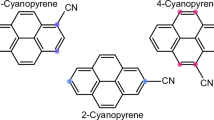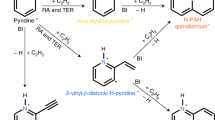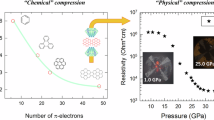Abstract
THE diffuse interstellar bands (DIBs), ubiquitous absorption features in astronomical spectra, have been known since early this century1 and now number more than a hundred. Ranging from 4,400 Å to the near infrared2, they differ markedly in depth, width and shape, making the concept of a single carrier unlikely. Whether they are due to gas or grains is not settled, but recent results3 suggest that the DIB carriers are quite separate from the grains that cause visual extinction. Among molecular candidates the polycyclic aromatic hydrocarbons (PAHs) have been proposed as the possible carriers of some of the DIBs4–7, and we present here laboratory measurements of the optical spectrum of the pyrene cation C16H10+ in neon and argon matrices. The strongest absorption feature falls at4,435 ± 5 Å in the argon matrix and 4,395 ± 5 Å in the neon matrix, both close to the strong 4,430-Å DIB. If this or a related pyrene-like species is responsible for this particular band, it must account for 0.2% of all cosmic carbon. The ion also shows an intense but puzzling broad continuum, extending from the ultraviolet to the visible, similar to what is seen in the naphthalene cation8 and perhaps therefore a common feature of all PAH cations. This may provide an explanation of how PAHs convert a large fraction of interstellar radiation from ultraviolet and visible wavelengths down to the infrared.
This is a preview of subscription content, access via your institution
Access options
Subscribe to this journal
Receive 51 print issues and online access
$199.00 per year
only $3.90 per issue
Buy this article
- Purchase on SpringerLink
- Instant access to full article PDF
Prices may be subject to local taxes which are calculated during checkout
Similar content being viewed by others
References
Herbig, G. H. Astrophys. J. 196, 129–160 (1975).
Herbig, G. H. Astrophys. J. 382, 193–203 (1991).
Snow, T. P. & Seab, C. G. Astrophys. J. 382, 189–192 (1991).
Van der Zwet, G. P. & Allamandola, L. J. Astr. Astrophys. 146, 76–80 (1985).
Leger, A. & d'Hendecourt, L. B. Astr. Astrophys. 146, 81–85 (1985).
Crawford, M. K., Tielens, A. G. G. M. & Allamandola, L. J. Astrophys. J. 293, L45–L48 (1985).
Allamandola, L. J., Tielens, A. G. G. M. & Barker, J. R. Astrophys. J. 290, L25–L28 (1985).
Salama, F. & Allamandola, L. J. Astrophys. J. (in the press).
Léger, A. & Puget, J. L. Astr. Astrophys. 137, L5–L8 (1984).
Shida, T. & Iwata, S. J. Am. chem. Soc. 95, 3473–3483 (1973).
Pankasem, S. & Thomas, J. K. J. phys. Chem. 95, 7385–7393 (1991).
Kira, A., Imamura, M. & Shida, T. J. phys. Chem. 80, 1445–1448 (1976).
Karcher, W., Fordham, R. J., Dubois, J. J., Glaude, P. G. J. M. & Ligthart, J. A. M. in Spectral Atlas of Polycyclic Aromatic Compounds (ed. Commission of European Communities) 92–95 (Reidel, Dordrecht. 1983).
Clar, E. & Schmidt, W. Tetrahedron 32, 2563–2566 (1976).
Salama, F. & Allamandola, L. J. J. chem. Phys. 94, 6964–6977 (1991).
Bondybey, V. E. & Miller, T. A. in Molecular Ions: Spectroscopy. Structure and Chemistry (eds Miller, T. A. & Bondybey, V. E.) 125–173 (North-Holland, New York, 1983).
Andrews, L., Kelsall, B. J. & Blankenship, T. A. J. phys. Chem. 86, 2916–2926 (1982).
Krelowski, J. in Interstellar Dust (eds Allamandola, L. J. & Tielens, A. G. G. M.) 67–86 (Kluwer, Dordrecht, 1989).
Salama, F. & Allamandola, L. J. J. chem. Phys. 95, 6190–6191 (1991).
Hayes, D. S., Mavko, G. E., Radick, R. R., Rex, K. H. & Greenberg, J. M. in Interstellar Dust and Related Topics (eds Greenberg, J. M. & Van de Hulst, H. C), 83–90 (Reidel. Dordrecht, 1973).
Van Breda, I. G. & Whittet, D. C. B. Mon. Not. R. astr. Soc. 195, 79–88 (1981).
Sellgren, K. Astrophys. J. 277, 623–633 (1984).
Sellgren, K., Luan, L. & Wener, M. W. Astrophys. J. 359, 384–391 (1990).
Aitken, D. K. & Roche, P. F. Mon. Not. R. astr. Soc. 202, 1233–1244 (1983).
Author information
Authors and Affiliations
Rights and permissions
About this article
Cite this article
Salama, F., Allamandola, L. Is a pyrene-like molecular ion the cause of the 4,430-Å diffuse interstellar absorption band?. Nature 358, 42–43 (1992). https://doi.org/10.1038/358042a0
Received:
Accepted:
Issue date:
DOI: https://doi.org/10.1038/358042a0
This article is cited by
-
The interstellar chemistry of PAH cations
Nature (1998)
-
Do two photons make a band?
Nature (1996)
-
The identification of diffuse bands
Astrophysics and Space Science (1996)
-
Organics in the diffuse interstellar medium
Origins of life and evolution of the biosphere (1996)



